
Rennet is a complex set of enzymes produced in the stomachs of ruminant mammals. Chymosin, its key component, is a protease enzyme that curdles the casein in milk. In addition to chymosin, rennet contains other enzymes, such as pepsin and a lipase.

Gruyère is a hard Swiss cheese that originated in the cantons of Fribourg, Vaud, Neuchâtel, Jura, and Berne in Switzerland. It is named after the town of Gruyères in Fribourg. In 2001, Gruyère gained the appellation d'origine contrôlée (AOC), which became the appellation d'origine protégée (AOP) as of 2013.

Halloumi or haloumi is a traditional Cypriot cheese made from a mixture of goat's and sheep's milk, and sometimes also cow's milk. Its texture is described as squeaky. It has a high melting point and so can easily be fried or grilled, a property that makes it a popular meat substitute. Rennet is used to curdle the milk in halloumi production, although no acid-producing bacteria are used in its preparation.
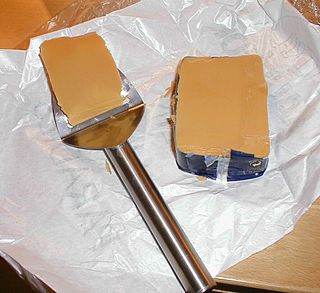
Brunost is a common Norwegian name for mysost, a family of cheese-related foods made with whey, milk, and/or cream. The term is often used to refer to Fløtemysost or Gudbrandsdalsost, which are the most popular varieties. Brunost is primarily produced in Norway and is popular there, Sweden, and in South Korea. It is regarded as one of the country's most iconic foodstuffs, and is considered an important part of Norwegian gastronomical and cultural identity and heritage.
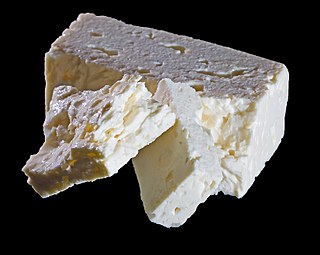
Feta is a Greek brined white cheese made from sheep's milk or from a mixture of sheep and goat's milk. It is soft, with small or no holes, a compact touch, few cuts, and no skin. Crumbly with a slightly grainy texture, it is formed into large blocks and aged in brine. Its flavor is tangy and salty, ranging from mild to sharp. Feta is used as a table cheese, in salads such as Greek salad, and in pastries, notably the phyllo-based Greek dishes spanakopita "spinach pie" and tyropita "cheese pie". It is often served with olive oil or olives, and sprinkled with aromatic herbs such as oregano. It can also be served cooked, as part of a sandwich, in omelettes, and many other dishes.

Goat cheese, goat's cheese, or chèvre, is cheese made from goat's milk. Goats were among the first animals to be domesticated for producing food. Goat cheese is made around the world with a variety of recipes, giving many different styles of cheese, from fresh and soft to aged and hard.
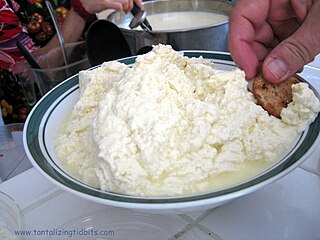
Ricotta is an Italian whey cheese made from sheep, cow, goat, or Italian water buffalo milk whey left over from the production of other cheeses. Like other whey cheeses, it is made by coagulating the proteins that remain after the casein has been used to make cheese, notably albumin and globulin.
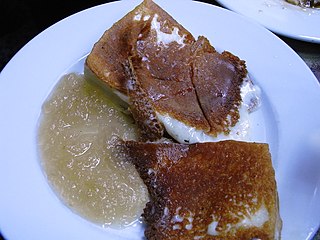
Majorero is a goat milk cheese from Spain. Similar to Manchego, this firm cheese has a milky, nutty flavour that goes well with various pear products. It is pale white in colour, and comes in large wheels. Currently, it is protected under European Law with Protected Designation of Origin (PDO) status.
Condrieu is a commune in the Rhône department in eastern France.

Goat milk is the milk of domestic goats. Goats produce about 2% of the world's total annual milk supply. Some goats are bred specifically for milk. Goat milk naturally has small, well-emulsified fat globules, which means the cream will stay in suspension for a longer period of time than cow's milk; therefore, it does not need to be homogenized. Eventually, the cream will rise to the top over a period of a few days. If the milk is to be used to make cheese, homogenization is not recommended, as this changes the structure of the milk, affecting the culture's ability to coagulate the milk and the final quality and yield of cheese.

Chabichou is a traditional semi-soft, unpasteurized, natural-rind French goat cheese with a firm and creamy texture. Chabichou is formed in a cylindrical shape which is called a "bonde", per the shape of the bunghole of a wine barrel. and is aged for 10 to 20 days. It is the only goat cheese that is soft ripened allowed by Protected Designation of Origin regulations to be produced using pasteurized milk. Chabichou is very white and smooth, and flexible to the palate, with a fine caprine odor.
Harbourne Blue is a goat's cheese produced by Ben Harris at Ticklemore Cheese Company in Devon, near Totnes, England. It is made by hand by using local milk. Maturation is around 10 weeks in which it forms a crumby, dense and firm texture with 48% fat content. It can easily overwhelm milder cheeses as the flavours are spicy and assertive.
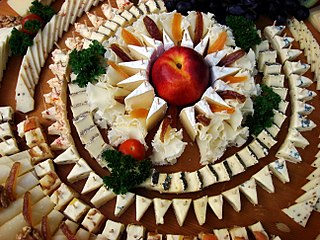
Cheese is a dairy product produced in wide ranges of flavors, textures, and forms by coagulation of the milk protein casein. It comprises proteins and fat from milk. During production, milk is usually acidified and either the enzymes of rennet or bacterial enzymes with similar activity are added to cause the casein to coagulate. The solid curds are then separated from the liquid whey and pressed into finished cheese. Some cheeses have aromatic molds on the rind, the outer layer, or throughout.

Lyonnaise cuisine refers to cooking traditions and practices centering on the area around the French city of Lyon and historical Lyonnais culinary traditions.
Civil peyniri is a brined string cheese that originated in Turkey.Civil cheese is one of the most important traditional foods, which produced and consumed especially in Kars and Erzurum. Civil peyniri a Turkish cheese made of sheep's milk, cow milk, goat milk, or a combination.













